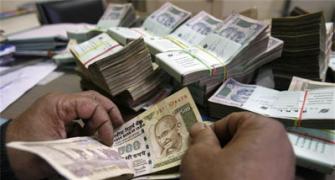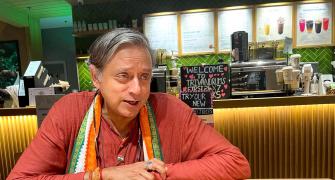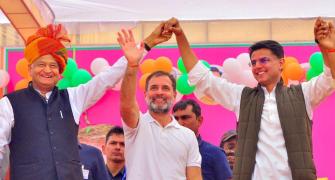Chief economic advisor Arvind Subramanian (bottom, left) discusses the Budget, goods and services tax, Centre-state relationship and larger issues facing the economy with Dilasha Seth, Arup Roychoudhury and Indivjal Dhasmana. Excerpts:

In the mid-year economic analysis, you talked of revisiting the fiscal numbers for 2016-17. Is it a view of the chief economic advisor (CEA) or that of the government?
I see my role as a member of the government. I am happy to be that. I do have a little bit of the thinker and the outsider role too. I see that as a responsibility. How to play these two is always tricky. So the fiscal consolidation suggestion is, may be, the latter role. This is analysis of what the government does and it should be aware of. So, in that sense, it is a hard technical analysis of the outlook going forward and what the constraints are.
Given the response you received for your analysis, are you willing to modify the position you took as a thinker?
The way I see it is that as a thinker, one puts forward some ideas, but the political process will then process them and then come up with a view, which will be taken at a much higher level. It will balance different considerations. If the final view is consistent with what I am saying, it is fine.
If it is slightly different, that too is fine. Part of my job is to put out ideas and analysis. I am not to make hard political choices. I give a lot of credit to this government for giving me a space to be articulate.
I don’t want to score political points here. I wonder, how many governments would have allowed a report like this (mid-year economic analysis of 2015-16). The finance minister and the government as a whole deserve a lot of credit for allowing me to write this report.
 You have analysed how the growth is not going to pick up next year compared to that in the current year. You also suggested revisiting the fiscal consolidation path and the debt-GDP ratio. How do you see this path?
You have analysed how the growth is not going to pick up next year compared to that in the current year. You also suggested revisiting the fiscal consolidation path and the debt-GDP ratio. How do you see this path?
We are working on a full-fledged medium-term scenario keeping in view the debt dynamics. At the end of the day, you are going to get very good arguments both for sticking to the path and to the recalibration of targets. I will present facts on both sides. Then, I may talk about pros or cons. In the mid-year report, we put out first preliminary analysis. Now we are going to do a much more detailed medium-term analysis.
The Budget for 2016-17 needs to be set in a medium-term framework. We are going to outline our debt sustainability vision. To be honest, I first smelt this change in dynamics when Q1 growth numbers came out. While everyone focused on real growth, for me the striking thing was that the nominal GDP came down. That is when I became sensitive to the fact that, going forward, the debt dynamics are going to be difficult.
You lowered the GDP forecast to 7-7.5% for the current financial year from earlier projection of 8.1-8.5 per cent in the Economic Survey. The lower end of the new projection is poorer than what other agencies such as the World Bank and IMF are forecasting. Are you just being cautious or you have lead indicators that these agencies may have missed to take note of?
I am more modest than others or just less competent. The data is genuinely difficult to interpret. We are at a time when reading the economy is not easy. Given uncertain times, you can do better than expected and also worse than expected. So, you have to allow for that.
By suggesting that fiscal consolidation roadmap for the next year be revisited, are you implying that the government should focus more on growth than fiscal deficit and RBI should focus more on growth than inflation?
I am not saying that we should not achieve the inflation target. We have to meet that. The only question is, what is the outlook for inflation going forward… is there a lot of spare capacity, is there not, is the core inflation high or not? That is one component… Then, I think, we have a flexible inflation targeting regime. I am not saying let us forget about inflation and focus on growth. I am completely with RBI that we have to meet the inflation objective.
You had earlier raised concern over the GDP numbers brought out by the Central Statistics Office, using the new methodology. Do you have same concerns even now, since nominal GDP does not include revenues generated from additional tax revenue measures?
I have thought hard about GDP numbers. There are two sets of issues. The concern I expressed earlier related to the 2013-14 number, which I still do not fully understand, but I need to understand. Then the new set of issues relating to the deflators emerged. The 2013-14 numbers have a lot to do with a change in the methodology for estimating GDP. The 2013-14 numbers will undergo revision in January, so let us see.
The other set of issues is not related to that but to two very unusual developments — the wide divergence between the CPI and the WPI, besides the very high increase in indirect taxes and how we should count this as part of GDP. These issues would have been the same under the old methodology too.
You have been saying that one should not expect any big bang reforms in normal times and you just mentioned that the Budget will be about the medium-term path that the economy should take. What do you think could be the top reforms or path a government can take at this stage?
I have been saying do not expect big bang reforms for two reasons — there is no crisis and a lot of levers are with the state governments. But there have been a lot of important reforms which could add up to something substantial. Of course, there is a scope for action from the central government as well. On the expenditure side, there is still scope for subsidy reforms. You can re-energise the direct benefit transfer.
On the tax side, major reforms are going to be GST, the ambitious corporate tax reform and cleaning up of the legacy issues. Then, there is a scope for disinvestment. I think one area we need to really make the centre stage of the Budget is agriculture. The focus should be on how to revive agriculture in the medium term. Agriculture had a boom phase when international prices and MSPs were going up. But in the last two years, it has shown how vulnerable agriculture really is. Especially in the context of climate change, we can’t afford to neglect agriculture.
Can simply increasing allocations for certain schemes help? How can the Centre ensure that the states improve implementation?
More resources always help. But that leads to the question of what is the value for money. It is a governance question about how the policy is implemented. So, resources plus good implementation will give you a good outcome. The Centre controls one of those, but not both. This is a much broader issue. As power is devolved more and more to states, how should we think about cooperative and competitive federalism? That is the bigger question, right?
In the old days when you allocated all the resources, you said (to states), you must do this and we will monitor you. Now the Centre is devolving more resources. The big question is how much do you rely on competitive federalism between states, and how much should you incentivise them. So all these aspects have to be on the table — the Centre’s carrot and stick policy and the Centre allowing competitive federalism.
The Budget for 2015-16 promised a lot in terms of strategic sales but that did not materialise. So, can we see that happen in a bigger way next year, and what is the best way to go about such divestment?
There are serious political obstacles to disinvestment. So the question is what is the best way of overcoming them? I won’t be able to talk about new structures like creating a ministry or a disinvestment commission. I think there is an underlying political economy which needs to be addressed and I haven’t thought about what the best way of doing that is. In some cases there are going to be labour issues, in some cases there will be other things. How best to take them on is not the issue that I have thought about seriously. There are models that exist but I haven’t yet thought seriously about that.
Where are we on the Expenditure Management Commission recommendations?
The government is looking at the recommendations. It will continue looking at them very carefully and will implement them as much as it can.
A committee headed by you on the goods and services tax suggested revenue neutral rate (RNR) which is 5-10 percentage points lower than that arrived at by the National Institute of Public Finance and Policy (NIPFP). What could be the reasons behind such a wide variance?
I think that Indian discussions on the RNR were informed by just one study for too long, which was the NIPFP report. Again, the government deserves credit for setting up the committee on GST under me, if for nothing else but to explore the different ways of arriving at RNR. There are different opinions on RNR and as it turns out, people come up with vastly different answers. In fact, the IMF way of doing it stuck close to 12 per cent. Once we saw that there were different approaches, we had to come to a judgment on which is the most plausible approach.
We had to be very careful with this because it is still the case that the empowered committee may take the NIPFP study as the received wisdom. So that shows how the discourse has been dominated by one study. We had to therefore examine that very closely and see what its limitations were. The RNR arrived at by NIPFP is now 21.5 per cent. We validated our analysis with multiple approaches and other cross-country comparisons.
The big benefit of the report is to bring in a lot more analysis and sources of information. We still may not be completely right, but we still have the chance to look at all the available information. That is why we are confident that the numbers we have recommended are likely to be closer to the “truth”.
Alcohol and petrol have been kept out of your calculations. What can be the impact on inflation once they are brought into GST rates?
The current state of empowered committee discussions is that constitutionally, petrol is in, but out for practical reasons. Alcohol is not like that. It is constitutionally out. What we have said is that both should be in, because that is what makes sense. We have done the calculations, in terms of inflation impact, without these things in. Should these things come in, the base will go up, and therefore, you will have a lower rate. Revenue neutrality works on the assumption that what you bring in and what you keep out should not affect inflation at an aggregate level.
Your suggestion on putting aerated drinks under sin tax has evoked protests from the industry.
We did not want to change any policy and we have not changed it. What we have put in the sin rate are basically things that are not charged at the standard rate. So we have not changed the policy. Whether that is good policy or bad policy is something that the empowered committee will decide.
You are against fixing GST rates in the Constitution amendment Bill. An alternative view suggested by many is to fix it in the GST Bill. How prudent are those suggestions?
It’s an absolute no-brainer. The GST council will decide on the rates. Fixing it in the constitution is an unambiguously bad idea. The GST council should fix the rates. My own personal view is that why should it fix a maximum rate? It should fix a rate and as things evolve that may need to be changed. There are a couple of things that get missed out in any discussion on GST. One is that the empowered committee and the GST council are examples of cooperative federalism in action in India.
If you have that structure, then that structure should make all these decisions. Why would the GST Council fix the maximum rate and curb its own freedom? Maybe today it is 17 (per cent), tomorrow it is 14 (per cent). It is a bit odd for the GST council to say that I will put constraints on myself, given that I am a political deliberative body to make these decisions.
Are you sure that your committee’s idea of removal of health and education from GST exemptions list would not work against the poor?
On this subject, we have been entirely driven by data. If you look at the data of who consumes education and health, it is mostly by the higher earning group of the population. Normally you would exempt such services because the perception is that they are consumed by the poor, but the data shows that’s not the case. It is something that people haven’t really noticed. We have done a lot of data analysis.
Now one can argue what about the poor who still consume a part of it. So for that, the exemptions should perhaps stay. But then it is very ineffective because it is not well-targeted. That is where the part of better targeting comes in, otherwise it becomes very ineffective. Policy should be informed by technical analysis of the data.
Assuming GST crosses the political hurdle in the Budget session, is it possible from a theoretical perspective to implement it in the middle of a financial year?
Theoretically, yes. In principle, yes. But a lot of homework needs to be done and groundwork to be laid. That call will have to be taken by more technical people.
Often we hear that not much attention is being paid to India’s trade policy. So what steps are necessary to strengthen our trade policy?
There is a near consensus in India on issues like WTO and trade negotiations. I think we need some collective self-interrogation on this. The world is moving very rapidly and we need to think about how we need to engage with the world.









